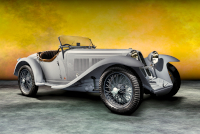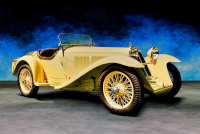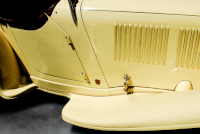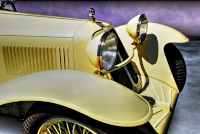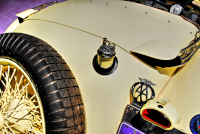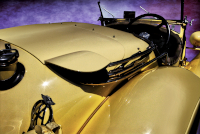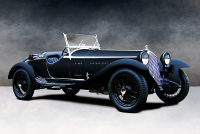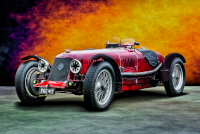Location:
Radnor Hunt Concours d'Elegance, 2012
Owner: Gary Ford | Pipersville, Pennsylvania
Prologue:
This is the 4CS Alain de Cadenet profiles in the Victory by Design Maserati film, his second drive after a Tipo 26 Grand Prix car. What many consider the first Maserati road car, #1114 is ostensibly a 4CS voiturette of no mechanical difference than its monoposto kin. And when Count Carlo Castelbarco removes the coachwork Brianza has made for the 1932 Salone Internazionale dell´Automobile Milano, he immediately returns #1114 to racing trim.
Castelbarco also installs a peppier 1500 cc motor and hydraulic brakes, which survive with the car today. But the true intrigue of chassis #1114 comes from its role in World War II during the East African campaign.
As to the notion of the first Maserati road car, I rather think #1114 is a near miss. That title may better suit a few early 8C 2500 cars bodied by Castagna, all of which are lost to the ages. And so, with a reproduction of its Brianza coachwork and the mechanical upgrades selected by Castelbarco, chassis #1114 must be the oldest Maserati road car as configured today. But, as with the balance of pre-War Maserati cars, in period no one presumed the car to be more than a pretty little racer.
One final note, while reviewing a period photograph of #1114 to describe the differences between the original car and its present configuration, I determined that I should attempt an illustration of the original coachwork. The main image depicts a fully re-bodied 4CS, with many differences in detail and proportion to recapture the original.
- - - - - - - - - -
► Image Source: Nikon D200 (10.2 MP) | Image Source 4 and 7 by E, used as the basis for illustrations by the author
References:
- Crump, Richard; de la Rive Box, Rob. "Maserati Sports, Racing and GT Cars from 1926" Third Edition, G.T. Foulis & Company for Haynes Publishing Group PLC, Somerset, England. 1992, page 44, 51, 54, 57
- Ferrington, Adam; Silva, Alessandro. "From Voiturettes to Formula 1: Maserati 1100cc and 1500cc racing and sports cars from 1931 to 1951" Fondazione Negri, Brescia, Italia. 2023, page 42, 43
- Maylam, Tony. "Victory by Design: Maserati" featuring Alain de Cadenet, Gemini Pictures, Goldcroft Films LLP, UK. 2003
- Autoweek: "1932 Maserati 4CS-1100: Off-track racer" by Jan Tegler, January 11, 2007
- Coachbuild: Source for the period 1932 Villa Olmo photograph on which we base our original illustration.
- Hemmings: "First production Maserati road car wins Best of Show at Hemmings Sports & Exotic Car Show" by Daniel Strohl, August 26, 2024
- UltimateCarPage: Snippets of three surviving 4CS cars, including chassis #1114, by Wouter Melissen, January 3, 2013.
For Maserati, sending a car to the Salone Internazionale dell´Automobile Milano is a small coup. The factory do not sell road cars mainly because their scale limits production, and customers pay Maserati to build race cars first, foremost, and exclusively. However, from factory drawings we see a clear interest in road cars, a supposition that one could take an 8C chassis, for example, and create a touring car.
This circumstance does, in fact, happen with the 8C chassis as of 1932. But rarely. We know of a fanciful 8C 2500 Maserati with a dual-cowl sports touring body by Castagna that appears at Villa d'Este in 1932. We also know of an 8C 2500 bodied by Castagna as a saloon. The date of the saloon car is unknown, certainly no later than 1932, or perhaps a few years after.
Those lost 8C 2500 chassis are the true first Maserati road cars, whereas this 4CS is an anomaly—one car that does not go to a gentleman driver or racing team, but instead to the Carrozzeria Brianza stand in Milano.
Even so, soon in the hands of Count Carlo Castelbarco, the original Brianza coachwork disappears and a 1500 cc motor replaces the original 1100 cc unit. Now a conventional Maserati voiturette, chassis #1114 goes racing, just as all of its kin. But the story of its survival is rather bizarre, as the car becomes an unlikely piece of booty.
World War II Spoils: Maserati 4CS 1100 #1114
Count Castelbarco passes the car to Romano Malaguti of Bologna in 1934, who later sells #1114 to one Giulio Ravasi on September 7, 1939. The classic era gives way to war, and Ravasi decides to send his 4CS to Asmara, Eritrea, along with (at least) two Alfa Romeo cars and 4CM #1122. The Ravasi brothers operate a garage in Asmara, and presumably believe that East Africa is safer than Italy.
To pad this decision point with political context, beginning in 1936, Mussolini takes control (or at least lays claim to) a broad territory formed by East African countries, which Italy term the Africa Orientale Italiana (AOI). In June of 1940, the Italians declare war, and by the end of the year take control of British Somaliland.
British forces eventually retake the Somalilands and invade AOI territory, using Eritrea as a point of focus. Italy surrender on May 19, 1941, and security in the region frees shipping through the Red Sea via the Suez Canal for the Allies.
About a year later, in 1943, Major R.M. Henning, a British officer in command of the region, discovers the cars Ravasi has stowed in Eritrea. As a motorsport enthusiast, he immediately recognizes the value of his find.
In an Autoweek story discussing the history of #1114, Jan Teger writes, "Coincidentally, he learned of a former race mechanic among his Italian prisoners. He put the mechanic to work tuning the Alfas and 4CS and marshaled the prisoners to build a road course. In the midst of the war, a race was held. After a few laps, the Alfas collided while avoiding a donkey and the 4CS won."
Henning then brings #1114 home, and by 1946 appears racing #1114 at the Prescott Hillclimb with rather bulbous coachwork—a fully skirted roadster, but a frumpy take on classic style. Henning (noted in some sources as R.C. Henning), wins first in class.
A 4CS Global Itinerary:
As Alain de Cadenet notes, chassis #1114 bounces between the US and the UK, and at turn of the century receives new coachwork while in England. This late rendition revitalizes the style of the original Milano show car, which is how the car appears today.
So, if we track chassis #1114 through history, its itinerary reads as follows:
- From Bologna, Italy to the Milano Maserati agent and the Salone Internazionale dell´Automobile Milano.
- From Italy to Asmara, Eritrea during World War II.
- From Eritrea to the UK after the war.
- From England to Northern Ireland in the care of Bobbie Baird, and later George Smyth, Jr. of Belfast.
- From Northern Ireland to the United States sometime in the post-War era.
- From the US back to the UK. And when the car's most recent restoration concludes under the ownership of Tony Merrick, chassis #1114 appears in 2004 at what is now known as the Classic Motor Show in Birmingham.
- From the UK to Lukas Hüni AG of Switzerland, where #1114 appears at the 2005 Techno Classica in Essen, Germany.
- From Germany to the US in autumn of 2005, care of Mr. Gary Ford.
In reviewing the itinerary of #1114, the story is reminiscent of Alfa Romeo 8C 2900B #412027, moving from Italy to Egypt, bouncing across the United States for a while, with a few touch-and-gos in Switzerland. And #412027 also passed through Lukas Hüni.
But there's no extraordinary significance to note, only coincidence of a somewhat predictable fashion. Classic European cars emigrated to Africa because England, France, and Italy held colonial interests across the continent. These sojourns kept the cars safe to some extent, and often placed them in the hands of officers who found the means to import them at the expense of their respective governments. So #1114 and #412027 are classic Italian sports cars that lived similar lives, indicating a pattern forged by geopolitical pressure, which is less remarkable the more one considers how astonishing war is in comparison.
Motor: 1,088 cc straight 4-cylinder, cast-iron block and head | 65 mm x 82 mm | 5.0:1 compression
In the mid-1930s, Count Carlo Castelbarco replaced the original 1100 motor with a 1500 unit of the following specification:
1,496 cc straight 4-cylinder, cast-iron block and head | 69 mm x 100 mm | 5:1 compression
Though not depicted here, the footwell extends all the way to the visible break between the two sets of bonnet side louvres, at the base of which sits the steering box housing. The motor sits forward in the nose, but still behind the front axle. The twin cam covers are dull, unpolished, and unadorned. The intake manifold uses a bladed design to aid cooling, though not nearly as sophisticated as an Alfa Romeo casting. In this case, narrow plates form a graduated terrace, which is probably less efficient than true cooling fins.
Valvetrain: DOHC, 2 valves per cylinder
Aspiration: single Weber carburetor, Roots-type supercharger
Power: 115 bhp at 5,000 rpm
This figure represents the current 4CS 1500 motor, uprated from the 4CS 1100 of 90 bhp @ 5,300 rpm.
Drivetrain: 4-speed non-synchromesh gearbox, rear-wheel drive
Front Suspension: rigid axle, semi-elliptic leaf springs, friction dampers
Rear Suspension: live axle, semi-elliptic leaf springs, friction dampers
Architecture: steel box-section frame, aluminum reproduction coachwork in the style of Brianza's original 1932 Milano coachwork
Kerb Weight: 809.6 kg (1,785 lbs)
The figure above is an estimate based on the approximate 1,800 lb weight cited by Jan Tegler in 2007. A race-prepared 4CS 1100 would weigh 700 kg (1,543.2 lbs), so we account for the heavier roadster coachwork.
Wheelbase: 2,700 mm (106.29 inches)
Top Speed: 146 km/h (90.7 mph)
Etymology:
'4CS' refers to the inline 4-cylinder motor of a 'sport' designation, which differs from the later 'corsa sport' nomenclature. The capacity would be 1100 cc, with coachwork by Brianza of Milan, and Maserati use '11' to designate the chassis numbers.
When Count Carlo Castelbarco replaced the 1100 cc motor with an uprated 1500 cc unit, he would have created an aftermarket 4CS 1500. However, no other sources label this car as a 4CS 1500. Perhaps the crucial point is that Maserati may not have been responsible for the motor swap, whereas the factory recorded other chassis transformations within the 4-cylinder range.
Today's coachwork also represents the car's original Salone Internazionale dell´Automobile Milano configuration, when at the time it was a 4CS 1100.
Figures:
If we need any indication of Maserati's highly specific production during the classic era, the 4CS 1100 is good evidence. In a six-year period, Maserati build five 4CS 1100 cars, one in 1931 (#1113), this car here in 1932 (#1114), and three in 1935 (#1123, #1124, and #1126). In 1936, the company also convert a 1500 cc car to 4CS 1100 specification (#1529), yielding six total 4CS 1100 cars.
To explain, the 4CS 1100 is the least of the early 4-cylinder inline voiturette cars, and Maserati produce more of every other variant, including the 4CM 1100, 4CM 1500, and 4CS 1500, though not by much.
Accounting for those chassis Maserati reconfigure by replacing a motor and changing the designation, Maserati build 35 examples of the 4-cylinder 1100 cc and 1500 cc voiturette. Maserati build all of these cars concurrently with their 8C Grand Prix cars from 1931 to 1936, with one lone 4CM 1100 built in 1937 for Giovanni Lurani.
Chassis #1114: The Milano Show Car versus the Reconstruction
Today's coachwork approximates Brianza's design, and while considering the differences between this and the original design, I developed an opinion that the latter does not achieve the balance of the original. Not to malign what is a handsome little roadster, I wanted to provide an impression of the original in honor of the proportion and style Maserati developed on the early 4C chassis. Notes on the original design are as follows:
The front wings move forward slightly to align the apex of the arch with the center of the wheel. The front edges form smooth blades, though not so spear-shaped as the reconstruction, and the fender is diminished in height. The entire wing tapers at a greater angle into an abbreviated board.
At the nose, the headlamps sit lower than the bonnet. The entire upper structure also sits low and flat, with little to no incline along the hinge from the nose to the windscreen. Louvres also shift downward, aligned in the middle of the bonnet sides. The bonnet seam appears to be vertical, rather than slanted.
On the flank, the door uses conventional straight panel seams and a gentle bowl-shaped cut along the sill, (which in period appears to sweep back up at the hip more than in my illustration, though this arrangement should be close). The lower door seam tapers down toward the rear wheel. The lower bolster over the frame also appears more pronounced, with a more noticeable lip emerging from the bodywork.
The rear fender is much diminished, much less bulbous to follow the arch of the wheel; it is also broader to give a more gentle arc. The fender's tail end does not flare so much as the reconstruction, but ends in a slim outward taper.
At the lower front edge of the rear fender, I retained the peculiar faux step seen on the reconstruction because it is an interesting feature that connects the front and rear running gear by visual gesture, but I diminished the form so as not to appear so clunky. The original may not have included this feature, but if so, perhaps it was so delicate.
The deck appears more linear, more in the style of the 1934 6C (#3026), and the spare tyre wears a cloth cover (not shown).
Quite important, the wheels and tyres appear to be slightly smaller on the original car. If indeed intended for road use, the wheelsets may have reflected a less aggressive stature. Also, when Count Castelbarco replaces the motor and brakes, he changes the car's footing as well. In the case of his monoposto, the wheels and tyres are much smaller, as shown in a photo published by Ferrington and Silva. These wheelsets would presumably survive the war, and appear to have been replaced with the larger sets of today in the post-War era.
Overall, the original form appears light, linear, and balanced. The car is smaller by proportion, its features much less pronounced. But I should add a few caveats.
I painted my illustrated 4CS grey with gunmetal wire wheels. I do not know the true original color, but chose this livery to differentiate the original form from the reconstruction. The basis for this illustration is a lone photograph posted on Coachbuild that purportedly depicts #1114 at Villa Olmo in 1932. The image shows the rear quarter perspective, the door open, though even in this orientation the car appears much different.
A post-War image depicts #1114 with R.M. Henning at Prescott (one I cannot presently locate), then wearing a stubby body of classic influence, though less refined than the current configuration.
In any case, I've extrapolated what I can based on one period photograph from the wrong way 'round, filled in by a sense of period Brianza coachwork and the broader 4CS family of cycle-fendered voiturette race cars. The result blends old and new, only with the intention of restoring the car's original proportions and balanced style.
Fascia Fanfare: 4CS Shroud Design
What we do see on the reconstruction is a fine example of Maserati's period grille, a double-domino shroud fully framed in chrome with a circular notch at the top inset with a red, blue, and gold badge.
Most captivating, the eight slats on the shroud between the irons form a fan pattern, four either side of the moulded starter crank tunnel. This design gives us a sense of what the marque identity would have looked like had Maserati taken up the business of road car manufacture in earnest. It is a handsome fascia, and one we'd have enjoyed in more plentiful number.
Last Updated: Mar 26, 2025

